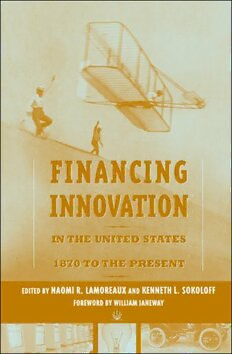
Financing Innovation in the United States, 1870 to Present PDF
Preview Financing Innovation in the United States, 1870 to Present
Financing Innovation in the United States, 1870 to the Present Financing Innovation in the United States, 1870 to the Present edited by Naomi R. Lamoreaux and Kenneth L. Sokoloff with a foreword by William Janeway The MIT Press Cambridge, Massachusetts London,England (2007MassachusettsInstituteofTechnology Allrightsreserved.Nopartofthisbookmaybereproducedinanyformbyany electronic or mechanical means (including photocopying, recording, or informa- tionstorageandretrieval)withoutpermissioninwritingfromthepublisher. MITPressbooksmaybepurchasedatspecialquantitydiscountsforbusinessor salespromotionaluse.Forinformation,[email protected] .edu or write to Special Sales Department, The MIT Press, 55 Hayward Street, Cambridge,MA02142. This book was set in Sabon on 3B2 by Asco Typesetters, Hong Kong, and was printedandboundintheUnitedStates. LibraryofCongressCataloging-in-PublicationData FinancinginnovationintheUnitedStates,1870tothepresent/editedbyNaomi R.LamoreauxandKennethL.Sokoloff;forewordbyWilliamJaneway. p. cm. Includesbibliographicalreferencesandindex. ISBN-13:978-0-262-12289-4(hardcover:alk.paper) 1.Hightechnologicalindustries—UnitedStates—Finance—History. 2.Technologicalinnovations—UnitedStates—Finance—History. I.Lamoreaux, NaomiR. II.Sokoloff,KennethLee. HC110.H53F56 2007 338.600410973—dc22 2006030095 10 9 8 7 6 5 4 3 2 1 A project organized by the Social Science ResearchCouncil Contents Foreword: William Janeway ix Acknowledgments xiii Introduction: The Organization andFinance ofInnovation in American History 1 Naomi R. Lamoreaux and Kenneth L.Sokoloff 1 Financing Invention during theSecond IndustrialRevolution: Cleveland, Ohio, 1870–1920 39 Naomi R. Lamoreaux, Margaret Levenstein, and Kenneth L. Sokoloff 2 The Organizing and Financing ofInnovativeCompanies inthe Evolution of the U.S. Automobile Industry 85 Steven Klepper 3 Why Did Finance Capitalism and theSecond IndustrialRevolution Arise in the 1890s? 129 Larry Neal and Lance E.Davis 4 Funding New Industries: AHistoricalPerspective on the Financing Role of the U.S. StockMarket in the TwentiethCentury 163 MaryA. O’Sullivan 5 Stock Market Swings and the Value of Innovation, 1908–1929 217 Tom Nicholas 6 Financing Fiber: Corning’s Invasion of the Telecommunications Market 247 MargaretB. W. Graham viii Contents 7 The Federal Role inFinancingMajor Innovations: Information Technology during the PostwarPeriod 283 Kira R. Fabrizio and David C. Mowery 8 Learning the Hard Way: IBMand theSources of Innovation in EarlyComputing 317 Steven W. Usselman 9 Trading Knowledge: AnExploration of Patent Protection and Other Determinants ofMarketTransactionsin Technology and R&D 365 AshishArora,Marco Ceccagnoli,and Wesley M.Cohen 10 The Governance of New Firms:AFunctional Perspective 405 Josh Lerner 11 Real Effects ofKnowledge Capital on Going Publicand Market Valuation 433 Michael R. Darby and Lynne G. Zucker 12 Afterword 469 Naomi R. Lamoreaux and Kenneth L. Sokoloff List of Contributors 475 Index 477 Foreword William Janeway Theideafortheprojectthatgeneratedthisbookoriginatedsometwenty years ago. Having participated in the sale of the investment banking partnershipF.Eberstadt&Co.toaglobalfinancialservicesgroup,Idis- covered the time to immerse myself in Fernand Braudel’s great work, Civilization and Capitalism (1982). In the second volume, The Wheels of Commerce, Braudel identifies the unique attribute of the capitalist— that which distinguishes him decisively from participants in both the regulated markets of the traditional economy and the nascent ‘‘free’’ markets that were rising to challenge them: ‘‘The characteristic advan- tage of standing at the commanding heights of the economy...consisted preciselyofnothavingtoconfineoneselftoasinglechoice,ofbeingable, as today’s businessmen would put it, to keep one’s options open’’ (381). My colleagues and I had been feeling our way into the emerging domain of venture capital. Braudel’s insight delivered a shock of rec- ognition, even as he amply documented that the sort of technological innovation that had become the focus of late-twentieth-century venture capitalists did not represent a relevant option for the preindustrial capitalists whose work he chronicled and placed in context. Braudel endorsed Simon Kuznets as‘‘absolutelyright when he says’’: Atthedangerofexaggeration,onemayaskwhethertherewasanyfixed,durable capital formation, except for the ‘‘monuments’’ in pre-modern times, whether therewasanysignificantaccumulationofcapitalgoodswithalongphysicallife that did not require current maintenance (or replacement) amounting to a high proportion of the original full value. If most equipment lasted no more than fiveorsixyears,ifmostlandimprovementshadtobemaintainedbycontinuous rebuildingamountingtosomethinglikeafifthofthetotalvalueperyears,andif mostbuildingsweredestroyedataratecumulatingtofairlycompletedestruction
